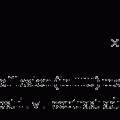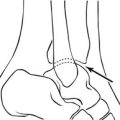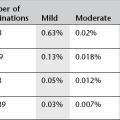Lacrimal system and salivary glands
Digital subtraction and CT dacryocystography
Dacryocystography allows visualization of the lacrimal system by direct injection of contrast into the canaliculus of the eyelid. It may be combined with CT imaging performed immediately following lacrimal system contrast injection. CT imaging gives additional diagnostic information, particularly about adjacent structures.1
Technique
1. The lacrimal sac is massaged to express its contents prior to injection of the contrast medium. The lower eyelid is everted to locate the lower canaliculus at the medial end of the lid.
2. The lower punctum normally measures 0.3 mm in diameter and is gently dilated. The lower lid should be drawn laterally to straighten the curve in the canaliculus. To avoid perforation, the cannula is initially positioned perpendicular to the eyelid margin as it enters the punctum. The cannula is then rotated by 90° horizontally along the natural curve of the lower canaliculus.
3. Care is taken not to advance the cannula too far into the canaliculus as proximal stenosis can be missed.
4. The upper canaliculus may also be cannulated if there is difficulty with the lower canaliculus.
5. The contrast medium is injected and a digital subtraction run at one image per second is obtained. This allows for a dynamic study in real time.
MRI of lacrimal system
Methods of imaging the salivary glands
1. Plain films: for calculus disease (sialithiasis)
2. Conventional sialography: less commonly performed than in the past; many indications replaced by non-invasive cross-sectional imaging
3. CT: thin-section unenhanced CT for diagnosis of sialithiasis ± intravenous (i.v.) contrast medium, e.g. in suspected tumour or abscess
4. Ultrasound (US): ideal investigation for superficial salivary gland disease and a sensitive test for sialithiasis
5. MRI: ± i.v. contrast medium for assessment of inflammatory or malignant disease, may include MR spectroscopy for characterization of focal mass and MR sialography
Coskun, B, Ilgit, E, Onal, B, et al. MR dacryocystography in the evaluation of patients with obstructive epiphora treated by means of interventional radiologic procedures. Am J Neuroradiol. 2012; 33(1):141–147.
Methods of Imaging the Salivary Glands
Bialek, EJ, Jakubowski, W, Zajkowski, P, et al. US of the major salivary glands: anatomy and spatial relationships, pathological conditions and pitfalls. RadioGraphics. 2006; 26(3):745–763.
Freling, NJ. Imaging of salivary gland disease. Semin Roentgenol. 2000; 35(1):12–20.
Rabinov, JD. Imaging of salivary gland pathology. Radiol Clin North Am. 2000; 38(5):1047–1057.
Yousem, DM, Kraut, MA, Chalian, AA. Major salivary gland imaging. Radiology. 2000; 216(1):19–29.
Conventional and digital subtraction sialography
Contrast medium
Neither contrast medium has a clear advantage over the other. Higher iodine concentration in Lipiodol provides excellent ductal delineation. However, foreign body reactions have been reported with lipid-soluble contrast agents. Newer, water-soluble contrast agents have similar iodine concentration to Lipiodol and are now used routinely.
Technique
1. The orifice of the parotid duct is adjacent to the crown of the second upper molar, and may be obscured by a mucosal bite ridge. Gentle abduction of the cheek using the thumb and index finger assists identification and cannulation of the parotid duct.
2. The orifice of the submandibular duct is on, or near, the sublingual papilla, lying next to the lingual frenulum. It is smaller than the parotid duct orifice and is more difficult to identify and cannulate. Raising the tip of the tongue, to touch the hard palate, puts tension on the papilla.
3. If the orifice is not visible, a sialogogue (e.g. citric acid) is placed in the mouth to promote secretion from the gland, and so render the orifice visible. The orifice is gently dilated using the silver probe and the cannula or polythene catheter is introduced into the duct. Care must be taken when advancing the cannula into the submandibular duct, due to the risk of painless perforation into the floor of the mouth.
4. Alternatively, modified Seldinger technique can be used, where a 0.018 inch guide wire is placed within the duct and a 22 gauge polythene catheter is advanced over the wire.
5. The catheter can be held in place by the patient gently biting on it. Up to 2 ml of contrast medium are injected. The injection is terminated immediately if any pain is experienced. The duct and acini should not be overfilled, as this may obscure ductal pathology.
Images
1. Dynamic images can be acquired during the injection at one frame a second. The advantage of the catheter technique is that both sides can be examined simultaneously
2. The occlusal film for the submandibular gland may be omitted, as this is only to demonstrate calculi
3. Post-secretory – the same views are repeated 5 min after the administration of a sialogogue. The purpose of this is to demonstrate sialectasis.
MRI of sialography
1. Patients are fasted for 4 hours before examination.
2. Heavily T2-weighted, fast spin-echo (HASTE and 3d T2 TSE) sequences with frequency-selective fat suppression are used for ductal evaluation.
3. Non-contrast studies can be useful in differentiating benign or low-grade malignant from high-grade malignant tumours.
4. Contrast enhancement is useful in the differential diagnosis of cystic from solid lesions, and when determining the degree of perineural spread of malignant disease.1
5. Diffusion-weighted imaging and MR spectroscopy are increasingly used for the characterization of salivary gland masses.2
6. Gadolinium-enhanced scans with T1 weighting and fat suppression are obtained in the axial plane; sagittal and coronal images may be obtained at the radiologist’s discretion.





